If you’re designing an ambitious field experiment that involves more than 3,800 plants and 240 deer cages, ecologist John Parker has some words of wisdom for you: beware of the unexpected. Beware of meadow voles. Parker is a senior scientist at the Smithsonian Environmental Research Center, in Edgewater, Maryland. He studies the relationship between plants and the herbivores that eat them.
In a recent paper published in Ecology Letters, Parker chronicles the ups, downs and findings of a study investigating the links between genetic diversity in plants and herbivory. “Most people think about biodiversity in terms of species diversity, where you have a rich variety of plants and animals living in an ecosystem,” explains Parker. “I’m interested in exploring the importance of genetic diversity within a species.” Scientists have recently discovered that plants can benefit from growing in genetically-rich polycultures, where neighboring plants of the same species have different genotypes. Parker’s new research shows that these benefits include better protection against hungry herbivores like deer and voles.
In the summer of 2007 Parker plowed the rocky soil of central New York to plant 476 patches of evening primrose (Oenothera biennis). Evening primrose is a burgeoning “lab rat” of the plant world, because the offspring are genetically identical to the parent plant. From the experiment’s inception, Parker knew the genetic make-up of each plant in his study; they were one of 20 different genotypes.
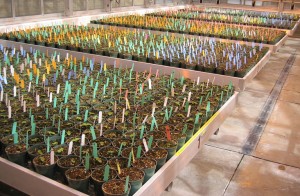
Parker needed to know the genetic make-up of each plant in his study, so he raised all 3,808 evening primrose (Oenothera biennis) plants from seedlings. Each plant was one of 20 different genotypes. Photo: John Parker
Parker designed the field experiment to explore questions about genetic diversity, natural selection and herbivory. Each patch contained 8 plants. Half of the patches were monocultures, containing plants with the same genotype. The other half grew in polycultures. Deer cages surrounded half of the patches, the other half were open to browsing.
The cages were set, the plants were in the ground and then Parker’s study took an unforeseen turn. A plague of meadow voles (Microtus pennsylvanicus) began eating the plants, eventually destroying more than 70% of them. “It was terrible. We literally had to watch where we stepped, there were so many voles. Initially I thought we were watching the total annihilation of the experiment,” said Parker.
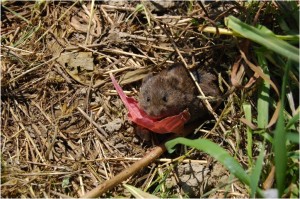
Voles destroyed more than 70% of Parker's experimental plants. Fortunately these attacks gave Parker important data about how plants benefit from growing in genetically-rich polycultures, where neighboring plants of the same species have different genotypes. Photo: Alex Smith
Fortunately herbivory was a key element of the experiment. Parker quickly shifted resources and began documenting the speed and impact of vole attacks. If deer grazing could tell him something about the role of genetic diversity in plant communities, then maybe munching by meadow voles could too.
At the end of the growing season, after the voles and deer had their way with the plants, Parker compared the monoculture patches with the polycultures. Seeds were a key measurement. These particular genotypes were annual plants and thus, the number of seeds a plant produced before it died was its total contribution to the genetic makeup of future generations.
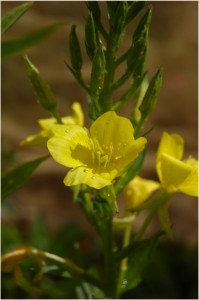
Parker planted evening primrose in monoculture and polyculture patches. At the end of the growing season, he found that the genetically-different polyculture patches produced more seeds. Photo: John Parker
Parker found that evening primrose produced more seeds when it was grown in polyculture than monoculture. Furthermore, the phenomenon was most pronounced in the patches that were open to deer browsing. The plants in these patches produced 200% more seeds than the same genotypes grown in monoculture. Scientists have recently discovered that genetic diversity within a plant species can have many benefits, but this study suggests that it may be even more important in the presence of predators.
Parker also looked deeper into the plants’ genetic make-up. He was interested in hereditary traits that might help the evening primrose tolerate or resist herbivore attacks. For each genotype he measured traits like plant chemistry, leaf toughness, stem diameter and “bolting phenology”—the number of days it takes a plant to transform from a short cabbage-like state to a plant with a stem and flowers.
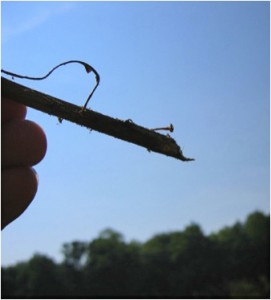
The silhouette of an evening primrose that suffered a vole-attack. Voles preferentially attacked 'early-bolters,' plants that were the first to grow a stem and flower. However, Parker found that these 'early-bolters' were more likely to survive the attacks if they grew in a diverse patch that included short, non-bolting plants. Photo: John Parker
The voles hit hardest during the initial weeks of the experiment. One of their eating techniques involves gnawing away at the outside of the stem. Ecologists call this “girdling.” Parker looked at the data from this early period and found that the voles preferentially attacked plants that bolted early. However, the “early bolters” were more likely to survive this initial feeding-frenzy if they grew in a diverse patch that included short, non-bolting plants. Parker says these successful early-bolters gained an “associational resistance” by being surrounded by plants that were less attractive to voles.
Scientists are groomed to be control-freaks. That is their job. But Parker looks back on this study and the vole plague and says, “Ecologists are recorders of nature. If something’s unfolding in front of you, the only option you have is to document it.” In this case, the voles strengthened Parker’s experiment and gave him additional insight into the complexity of the system.
Parker does not have any vole-studies planned for the immediate future. However, his deer explorations continue. Most recently he’s investigating the impact of deer on invasive plants in the woods surrounding the Smithsonian Environmental Research Center.
Parker’s paper is available online:

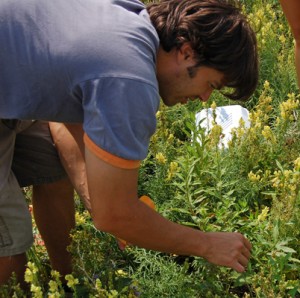

Hi!
I think voles can influence wetland plant communities also. They sure like Juncus, a native plant.